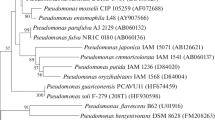Summary
Pseudomonas sp. CBS3 converted various nitro-aromatic compounds under aerobic resting-cell conditions to the corresponding amino compounds. Mononitro-compounds were reduced to anilines. 1-Chloro-2,4-dinitrobenzene was reduced via the two possible chloronitroanilines to 4-chloro-1,3-diaminobenzene. In the case of 2,4,6-trinitrotoluene, two monoaminodinitrotoluenes and one diaminomononitrotoluene were obtained. In addition to the reduction, in most cases the amines were partially acetylated. In experiments under an argon atmosphere conversion of the nitro-compounds was as fast as under aerobic conditions. Cells of Pseudomonas sp. CBS3 cultivated on complex medium showed higher nitro-reducing activity than those cultivated on mineral salts medium with 4-chlorobenzoate as substrate, which is normally used as medium for this strain. Several other Pseudomonas species (ATCC 4359, ATCC 23937, ATCC 15005, ATCC 17933) also showed nitro-reducing activities. In crude cell-free extracts of Pseudomonas sp. CBS3 an enzyme catalysing the reduction of nitro-aromatics was detected. The enzyme was inactivated by dialysis and was reactivated by the addition of NADH or NADPH. NADPH was the more efficient co-substrate.
Similar content being viewed by others
References
Angermeier L, Simon H (1983) On nitroaryl reductase activities in several clostridia. Hoppe-Seyler's Z Physiol Chem 364:1653–1664.
Bratton AC, Marshall EK Jr, Babitt D, Hendrickson AR (1939) A new coupling component for sulfanilamide determination. J Biol Chem 128:537–550.
Bruhn C, Lenke H, Knackmuss H-J (1987) Nitrosubstituted aromatic compounds as nitrogen source for bacteria. Appl Environ Microbiol 53:208–210.
Cartwright MJ, Cain RB (1959) Bacterial degradation of the nitrobenzoic acids. Biochem J 73:305–314.
Fernando T, Bumpus JA, Aust SD (1990) Biodegradation of TNT (2,4,6-trinitrotoluene) by Phanaerochaete chrysosporium. Appl Environ Microbiol 56:1666–1671.
Germanier R, Wuhrmann K (1963) Über den aeroben mikrobiellen Abbau aromatischer Nitroverbindungen. Pathol Microbiol 26:569–578.
Hallas LH, Alexander M (1983) Transformation of nitroaromatic compounds in sewage effluent. Appl Environ Microbiol 45:1234–1241.
Harada N, Omura T (1980) Participation of cytochrome P-450 in the reduction of nitrocompounds by rat liver microsomes. J Biochem 87:1539–1554.
Hsu T-S, Bartha R (1976) Hydrolyzable and nonhydrolyzable 3,4-dichloroaniline-humus complexes and their respective rates of biodegradation. J Agric Food Chem 24:118–122.
Jensen HL, Lautrup-Larson G (1967) Microorganisms that decompose nitroaromatic compounds, with special references to dinitro-ortho-cresol. Acta Agric Scand 17:115–125.
Kinouchi T, Manabe Y, Wakisaka K, Ohnishi Y (1982) Biotransformation of 1-nitropyrene in intestinal anaerobic bacteria. Microbiol Immunol 26:993–1005.
Klages U, Lingens F (1980) Degradation of 4-chlorobenzoic acid by a Pseudomonas sp. Zentralbl Bakteriol Parasitenkol Infektionskr Hyg, I Abt Orig C 1:215–223.
Lingens F, Oltmanns O (1966) Isolierung und Charakterisierung eines chloramphenicolabbauenden Bakteriums. Biochim Biophys Acta 130:336–344.
McCormick MG, Feeherry FE, Levinson HS (1976) Microbial transformation of 2,4,6-trinitrotoluene and other nitroaromatic compounds. Appl Environ Microbiol 31:949–958.
Meijers AP (1988) Organische Spurenstoffe im Rheinwasser und Rheinuferfiltrat. Das Gas- und Wasserfach, Wasser-Abwasser 129:208–211.
Parris GE (1980) Environmental and metabolic transformations of primary aromatic amines and related compounds. Residue Rev 76:1–30.
Pée K-H van, Salcher O, Lingens F (1981) Synthese von 7-Chlor-l-und 7-Chlor-d-tryptophan; Biosynthese von Pyrrolnitrin. Liebigs Ann Chem 2:233–239.
Raistrick H (1949) Chloromycetin: its structure and synthesis. Nature 163:553–554.
Rosenkranz HS, Mermelstein R (1983) Mutagenicity and genotoxicity of nitroarenes: all nitro-containing chemicals were not created equal. Mutat Res 114:217–267.
Shimizu M, Yano E (1986) Mutagenicity of nitrobenzene derivatives in the Ames test and rec assay. Mutat Res 170:11–22.
Sylvestre M, Massé R, Messier F, Fautex J, Bisaillon J-G, Beaudet R (1982) Bacterial nitration of 4-chlorobiphenyl. Appl Environ Microbiol 44:871–877.
Tatsumi K, Kitamura S, Yoshimura H, Kawazoe Y (1978) Susceptibility of aromatic nitrocompounds to xanthin oxidase-catalyzed reduction. Chem Pharm Bull 26:1713–1717.
Won WD, Heckly RJ, Glover DJ, Hoffsommer JC (1974) Metabolic disposition of 2,4,6-trinitrotoluene. Appl Microb 27:513–516.
Zeyer J, Kocher P, Timmis N (1986) Influence of para-substituents on the oxidative metabolism of ortho-nitrophenols by Pseudomonas putida B2. Appl Environ Microbiol 52:334–339.
Author information
Authors and Affiliations
Additional information
Offprint requests to: R. Müller
Rights and permissions
About this article
Cite this article
Schackmann, A., Müller, R. Reduction of nitroaromatic compounds by different Pseudomonas species under aerobic conditions. Appl Microbiol Biotechnol 34, 809–813 (1991). https://doi.org/10.1007/BF00169355
Received:
Accepted:
Issue Date:
DOI: https://doi.org/10.1007/BF00169355




